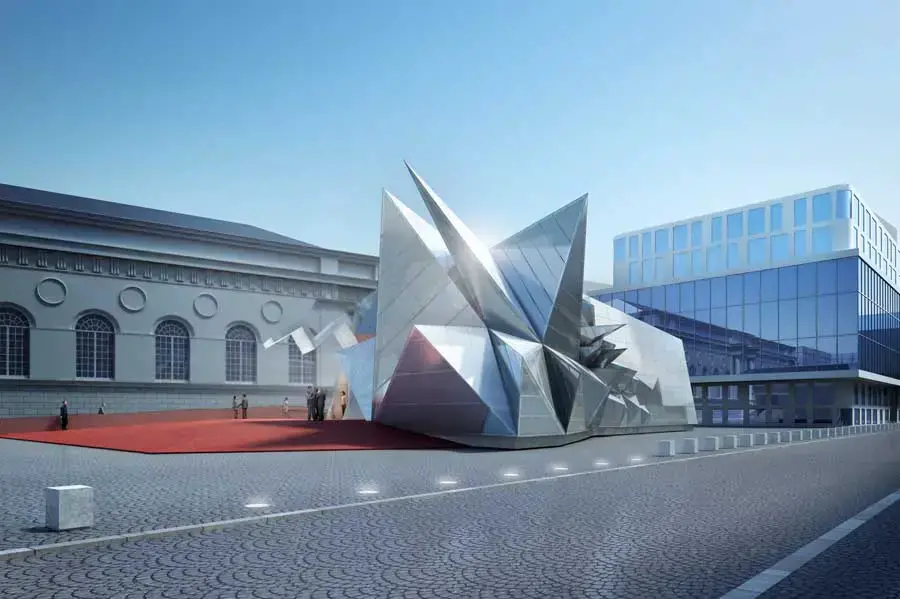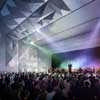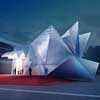Pavilion 21 MINI Opera Space, Munich temporary mobile performance building, Marstallplatz project, German design images
Pavilion 21 MINI Opera Space Munich
Temporary mobile performance space, Germany design by COOP HIMMELB(L)AU, Architects, Vienna.
24 Nov 2009
PROJECT “PAVILION 21 MINI OPERA SPACE”, MUNICH, GERMANY (2008-2010)
Design: COOP HIMMELB(L)AU
CONCEPT
Marstallplatz Project Munich
The ‘Pavilion 21 MINI Opera Space‘ is a temporary mobile performance space for 300 visitors to be located on the Marstallplatz in the City of Munich. It is intended to be used for a wide range of events at the annual Opera Festival 2010 and then to travel to other locations.
The design approach studies the impact of physical influences on our hearing perception and how to apply soundscape effects to alter our sensation through transforming and adopting building volumes and their material specifications. Contrary to our built environment sound or music has no present materiality so it is always perceived at the moment of its generation. Because of this immediate perception of sound our sensations could range from supreme beauty to painful intolerability. In architecture and urban planning soundscaping design approaches of exterior spaces are barley recognized and hardly ever applied therefore many public spaces are unattractive in our psychological perception.
The design goal for the pavilion is to impact a unique soundscape by helping to reduce the apparent noise and to create a ‘zone of silence’ next to the pavilion. Creating an absolute ‘zone of silence’ is technically not possible, but this term used here is intended to describe an area where you can sense a change in the soundscape that gives the impression of a quieter environment.
This strategy for achieving this concept uses three mechanisms, firstly the shielding effect of the plaza to block sound from the road, secondly the shaping of the pavilion surface to collect and deflect sound and thirdly the material characteristic of the Pavilion surface to absorb and reflect sound.
The Pavilions spatial structure acts here as a “transformator” that changes our perception and sensation of the soundcape and music on the plaza around the Pavilion and inside the performance space.
Parallel to acoustical approaches and simulations, the generation of the form of the Pavilion was driven by the concept of materializing music into architecture. Selected sequences of songs become dynamic forces that transform and create spatial form. Here we transcribed a sequence of Jimi Hendrix’ “Purple Haze” “…’Scuse me while I kiss sky…”. Analyzing the frequencies of the sound file and linking it to the computer generated 3D model, the scripting tool then parametrically transforms the shell into pyramid shapes like spikes. Music is frozen and creates architectural space.
To meet internal acoustics design objective, the proposal includes provision for a combination of perforated sound absorbing panels and pyramid-shaped, non-perforated sound diffusing panels on the side walls and ceiling, with a sound reflective floor and stage. Sound-reflective parallel surfaces between the side-walls and between the floor and ceiling are avoided here and are therefore tilted and rotated in relationship to the generated exterior shape.
The interior performance space has overall clear dimensions of 21 m length and 17m width and a variable clear height from 6m to 8m. The backstage service area is conceived as a flexible open space for artists changing room and storage.
Pavilion 21 MINI Opera Space – Building Information
ARCHITECTS: COOP HIMMELB(L)AU – Wolf D. Prix / W. Dreibholz & Partner ZT GmbH
DESIGN PRINCIPAL: Wolf D. Prix
PROJECT PARTNER: Paul Kath
PROJECT ARCHITECT: Volker Kilian
DESIGN ARCHITECT: Sophie Grell
PROJECT TEAM: Martin Jelinek, Valerie Messini, Judith Mussel, Martin Neumann, Renate Weissenböck
VISUALIZATIONS: Isochrom / Armin Hess
CLIENT: The Free State of Bavaria represented by
The Bavarian State Opera Munich, Germany
GENERAL CONTRACTOR: Frener & Reifer Metallbau GmbH, Augsburg, Germany
ACOUSTICS: ARUP, London, UK
DATA:
BUILDING COSTS EUR 2.1 Mio net (excl. VAT)
DIMENSIONS:
SITE AREA 1.790 m²
NET AREA 430 m²
GROSS AREA 560 m²
FOOTPRINT 560 m²
VOLUME 4.350 m³
HEIGHT 12.5 m
LENGTH 38.5 m
WIDTH 25.5 m
CHRONOLOGY:
ACQUISITION/ STUDY 02/2008
PLANNING START 10/2009
CONSTRUCTION START 04/2010
OPENING 06/2010
Pavilion 21 MINI Opera Space images / information from COOP HIMMELB(L)AU
Location: Munich, Bavaria, Germany, western Europe
Munich Architecture Developments
Contemporary Munich Buildings
Munich Architecture Design – chronological list
Munich Architecture Walking Tours – architectural walks by e-architect – experienced building guides
Baramundi Headquarters, Augsburg Innovation Park, Augsburg, Swabia, Bavaria, southern Germany
Architects: HENN
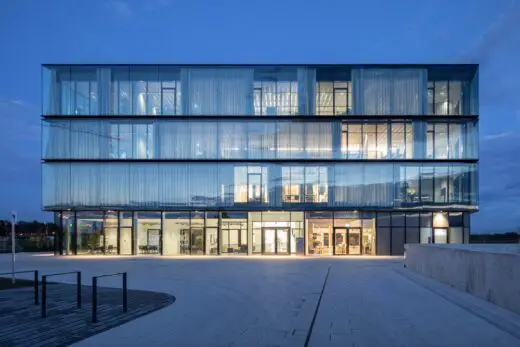
photo : Laurian Ghinitoiu
Baramundi Headquarters
Climate-neutral Event Arena
Design: Populous
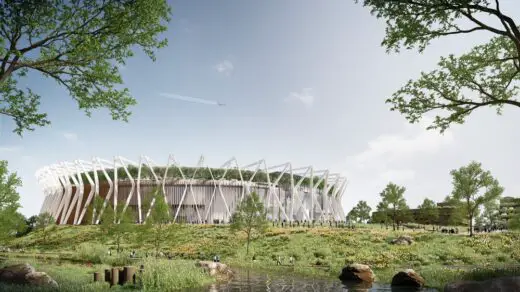
render © Populous
Climate-neutral Event Arena Munich
Munich Hotel Buildings Complex
schmidt hammer lassen architects
Munich Hotel Buildings
BMW Welt – Event and Delivery Center
Coop Himmelb(l)au
Munich building : BMW Welt
Lenbachhaus Museum – Extension + Restoration, Richard-Wagner Strasse
Foster + Partners
Lenbachhaus Museum
Comments / photos for the Pavilion 21 MINI Opera Space Munich Architecture design by COOP HIMMELB(L)AU Architects, Vienna, Austria, page welcome

